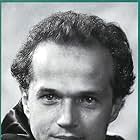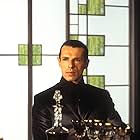In 1870 Russia, a group of young and idealistic anarchists plots to overthrow the established order through violent means.In 1870 Russia, a group of young and idealistic anarchists plots to overthrow the established order through violent means.In 1870 Russia, a group of young and idealistic anarchists plots to overthrow the established order through violent means.
- Awards
- 1 nomination
Storyline
Did you know
- ConnectionsVersion of Nikolay Stavrogin (1915)
Featured review
Nikolai Stavrogin is a person that tries to prove his freedom by believing in nothing and mocking everything and everyone around him. Unfortunately, he is also a handsome and charismatic man, influencing many people. So, "the devils went out of this Russian man and entered into a herd of swine..."; his eloquent (but meaning nothing to himself) speeches leave deep marks in others and cause a lot of suffering and even death.
Although Stavrogin is the central character of the Dostoyevsky's novel, in this movie it is not so. He disappears about half an hour before the end. Instead, the movie is focused on Shatov, the only character one could possibly identify with. I guess Wajda wanted us to see the story from Shatov's viewpoint.
Some parts of this story are transferred to screen nicely; however other important parts are only touched or completely missing. Many important characters pass unnoticed. I guess the natural thing to think is that such a complex and long novel can not be faithfully dramatized. However, having seen a theater adaptation in Narodno pozorite in Belgrade, I can testify that this is not true. I would probably think much more of this movie if I haven't previously seen the play.
I wonder whether someone who hasn't read the novel could follow the plot. My impression is that they couldn't, and that the movie addresses mostly those who have.
There are also other minor objections. For example, Isabelle Huppert gets first billing although she appears for less than 10 minutes. Nevertheless, the movie complements the book fine and I feel that Dostoyevsky admirers should see it.
Although Stavrogin is the central character of the Dostoyevsky's novel, in this movie it is not so. He disappears about half an hour before the end. Instead, the movie is focused on Shatov, the only character one could possibly identify with. I guess Wajda wanted us to see the story from Shatov's viewpoint.
Some parts of this story are transferred to screen nicely; however other important parts are only touched or completely missing. Many important characters pass unnoticed. I guess the natural thing to think is that such a complex and long novel can not be faithfully dramatized. However, having seen a theater adaptation in Narodno pozorite in Belgrade, I can testify that this is not true. I would probably think much more of this movie if I haven't previously seen the play.
I wonder whether someone who hasn't read the novel could follow the plot. My impression is that they couldn't, and that the movie addresses mostly those who have.
There are also other minor objections. For example, Isabelle Huppert gets first billing although she appears for less than 10 minutes. Nevertheless, the movie complements the book fine and I feel that Dostoyevsky admirers should see it.
- How long is The Possessed?Powered by Alexa
Details
- Release date
- Country of origin
- Language
- Also known as
- Die Dämonen
- Filming locations
- Bialowieza, Podlaskie, Poland(train station)
- Production companies
- See more company credits at IMDbPro
Box office
- Budget
- $575,000 (estimated)
Contribute to this page
Suggest an edit or add missing content





















